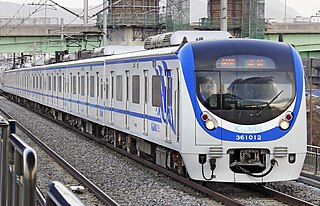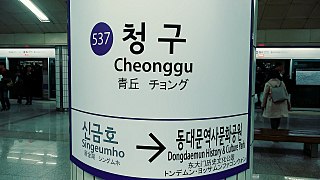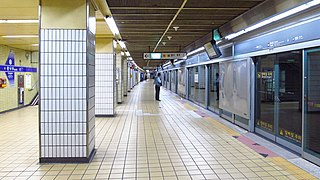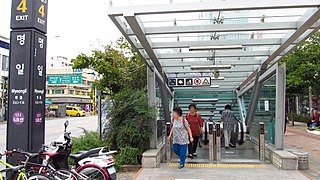
The Gyeongchun Line is a regional rail line between Seoul and Chuncheon, South Korea, operated by Korail. Its name is derived from Gyeong and Chuncheon. It was completely reconstructed in the 2000s. Service on it has operated between Sangbong station on the Jungang Line in eastern Seoul and Chuncheon station, as part of the Seoul Metropolitan Subway system, since December 21, 2010. A class of regional rail service named ITX-Cheongchun began operations on February 28, 2012, linking Chuncheon to Cheongnyangni and Yongsan Stations.

Seoul Subway Line 2, also known as the Circle Line, is a circular line of the Seoul Metropolitan Subway. The line running clockwise is called the "inner circle line" and the counter-clockwise line is called the "outer circle line". This is Seoul's most heavily used line, and consists of the main loop, the Seongsu Branch and the Sinjeong Branch for a total line length of 60.2 km (37.4 mi). The Line 2 loop is the third longest subway loop in the world after Moscow Metro Bolshaya Koltsevaya line and Beijing Subway Line 10. In 2019, Line 2 had an annual ridership of 812 million passengers or 2.2 million passengers per day.

Seoul Subway Line 8 of the Seoul Metropolitan Subway was built from 1990 to 1999 and mainly serves the southeastern parts of Seoul and Seongnam. The first section from Jamsil to Moran opened in 1996, and the second section from Moran to Amsa was opened in July 1999. The line color is rose. In 2019, Line 8 had an annual ridership of 112 million or about 307,000 people per day. At 17.7 km (11.0 mi) in length, Line 8 is the shortest of all heavy rail Seoul Metropolitan Subway lines.

Seoul Subway Line 9, operated by Seoul Line9 Operation, is a subway line in Seoul, part of the Seoul Metropolitan Subway. The line runs east from Gaehwa station or Gimpo International Airport station along the south bank of the Han River towards VHS Medical Center in Gangdong. In 2019, Line 9 had an annual ridership of 225 million or about 616,000 people per day.

Hyehwa Station (Korean: 혜화역) is a station on the Seoul Subway Line 4 in Jongno District, Seoul. It is located in the center of the area commonly known as Daehangno, and much of the ridership of this station comes from the nightlife scene. The Seoul National University Yongon campus, housing its Hospital and School of Medicine, is located to the southwest.

Gwanghwamun Station (Korean: 광화문역) is a station on the Seoul Subway Line 5 in South Korea. It is not the closest subway station to the actual gate of Gwanghwamun, which it is named after. It is located next to the U.S. Embassy in Seoul.

Yeongdeungpo District is an administrative district in southwest Seoul, South Korea. Although the origin of the name is uncertain, the first two syllables are thought to be from "yeongdeung" (靈登) or "divine ascent", a shamanic rite. The third syllable is "po", representing the bank of a river (浦), referring to the district's position on the Han River. The 2006 population was 408,819.

Gangdong District is one of the 25 gu that make up the city of Seoul. Gangdong, literally means "east of river".

Guro District is a district of Seoul, South Korea, which was separated from Yeongdeungpo District on April 1, 1980. Located in the southwestern part of the city, where besides Yangcheon District and Geumcheon District Guro District has an important position as a transport link which contains railroads, land routes from the rest of Seoul to the south of the country. The Gyeongbu and Gyeongin railway lines connect Seoul to Busan and Incheon. In addition, Seoul Metropolitan Subway lines 1, 2, and 7, and major highways intersect in Guro District.

Cheonggu Station is a subway station located in Jung District, Seoul, South Korea. This station is served by Line 5 and Line 6 of the Seoul Subway.

Gwangnaru Station is a station on the Seoul Subway Line 5 in Gwangjin-gu, Seoul. Its station subname is Presbyterian Univ. & Theological Seminary, where said university is nearby Exit 2.

Gil-dong Station is a subway station on Seoul Subway Line 5 in Gangdong District, Seoul. There is a connecting track from this station to Dunchon-dong Station on the Macheonji Line of Line 5, but it is a return train track for the arrival and departure of the Godeok Vehicle Business Office and has nothing to do with passenger operations.

Sangil-dong station is the subway station of Line 5 in Gangdong-gu, Seoul. Seoul Metro have extended the subway line from this station to Hanam Geomdansan in the nearby city of Hanam.

Samseong-Dong is an affluent neighborhood or ward of Gangnam-gu in Seoul, South Korea.

Godeok-dong is a dong (neighborhood) of Gangdong District, Seoul, South Korea.
Myeongil-dong is a dong, neighbourhood of Gangdong-gu in Seoul, South Korea.
Sangil-dong is a dong, neighbourhood of Gangdong-gu in Seoul, South Korea.

Seojeongni Station is a station in Seojeong-dong, Pyeongtaek, South Korea. Mugunghwa-ho trains running on the Gyeongbu Line stop here. Additionally, services on Seoul Subway Line 1 have been calling at this station since 2005. Its station subname is Kookje College.

Gubeundari Station is a subway station on Seoul Subway Line 5 in Gangdong District, Seoul.

Myeongil Station is a subway station on Seoul Subway Line 5 in Gangdong-gu, Seoul.



















